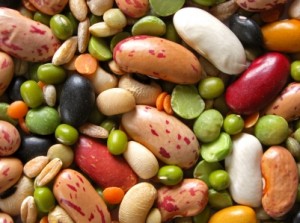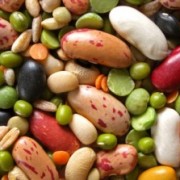Healthy Proteins Found In Legumes!
Legumes
Beans, peas, and lentils serve as excellent sources of fiber, protein, iron, and complex carbohydrates. The single common identifying factor among all legumes is that they grow as seeds within a pod. Dried beans have served as a dietary staple since the Bronze Age.
Soybeans are unique in that, compared to other plant sources, they have relatively high protein and fat content, and can be utilized to make textured vegetable protein, soy milk, tofu, meat analogs, and fermented soybean foods.
Textured Vegetable Protein
Textured vegetable protein (TVP) is derived mainly from soybeans, but other plants such as peanuts and cottonseed may be used. In TVP, the plant material has been altered into fibrous, porous granules that rehydrate rapidly TVP is often used to extend ground meats in order to lower costs and/or reduce fat content. The USDA limits the use of TVP in commercially prepared foods to no more than 30  Legumespercent of any particular product. One cup of TVP is usually rehydrated in cup liquid before being added to hamburgers, hot dogs, chilis, tacos, spaghetti, lasagna, soups, meatloaf, pizza toppings, or other dishes. TVP burns easily, so it should be added only after the meat has been browned. It also retains moisture and contributes to texture by maintaining cohesiveness. TVP is available flavored or unflavored, and natural or caramel-colored.
Legumespercent of any particular product. One cup of TVP is usually rehydrated in cup liquid before being added to hamburgers, hot dogs, chilis, tacos, spaghetti, lasagna, soups, meatloaf, pizza toppings, or other dishes. TVP burns easily, so it should be added only after the meat has been browned. It also retains moisture and contributes to texture by maintaining cohesiveness. TVP is available flavored or unflavored, and natural or caramel-colored.
Meat Analogs
Meat analogs are imitations of meat products that are made by blending soy protein with other vegetable proteins, carbohydrates, fats, vitamins, minerals, colorings, and flavors. There are meat analog products that can stand in for breakfast sausages, bacon, ham slices, and chicken or beef chunks. These products contain one-third the fat when compared to the original meats, and no cholesterol; however, depending on how they are made, the protein quality is usually low, since soy protein lacks sufficient amounts of the essential amino acid methionine. They are also higher in sodium and more costly than the meats they simulate.
Fermented Soybean Foods
The fermentation of soybeans results in a number of different foods:
- Miso. A fermented soybean paste, which is used as a seasoning for soups, stews, dressings, dips, sauces, and gravies.
- Natto. A snack or entree made from fermented cooked soybeans held together by a sticky bacterial product.
- Sufu. Fermented tofu, also known as bean cake.
- Tempeh. A snack or meat alternative entrée made from fermented whole soybeans molded into a cake.
- Tamari. A naturally aged and fermented soy sauce.
http://www.asianonlinerecipes.com/tips/healthy-proteins-found-in-legumes/




